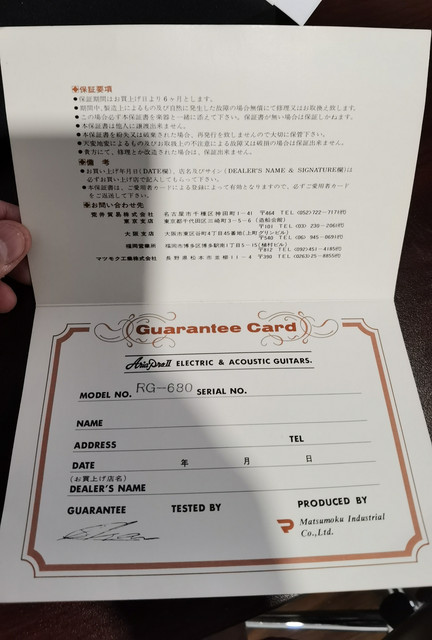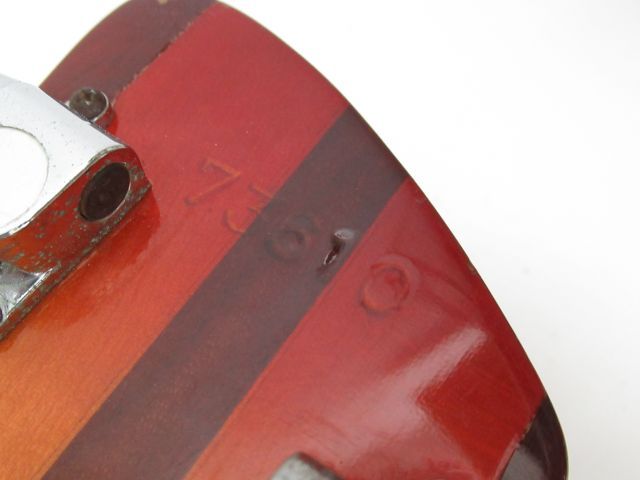Here's a fairly unusual one, in more than one sense, an Aria Pro II RG-680B. It's the only Japanese copy of a Rickenbacker 620, a solid-body model that might well have fallen through the cracks of history hadn't Tom Petty seen fit to sport a 12-string version of it on the cover photo of the 1979 Heartbreakers album "**** The Torpedoes". This guitar is difficult date exactly, but 1977-78 seems likely, so it's not produced to cash in on any interest in the 620 that that might have generated. Just one more case of "why on earth did they copy that?", I guess.
Either way, it's an excellent guitar, a solid Matsumoku build, surprisingly hefty for such a small guitar, weighing in at just over 3.8 kg. It's all-maple construction, like the original. It's a really close copy generally, featuring the double mono/stereo outputs and that weird fifth knob, which is a pretty counterintuitive pickup balance control. Sure, the neck pickup is significantly louder than the bridge and there is very little pickup height adjustment range, but it does have separate volume and tone controls to begin with. The fifth knob lets you lower the output of the neck pickup by turning it to the right (i e "up")... but not all the way down. I don't really get it, but Rickenbacker is not really know for doing things in a conventional way, and Aria seem to have copied the feature faithfully.
Btw, I love how the P in "Pro" in the logo has been incorporated into the string anchor design.
This one arrived in quite good condition... except for having dead pickups. The bridge pickup turned out to have a coil break, while the neck pickups was just an empty bobbin with no wire at all. I've no idea what happened there, but after I got the original resistance value for the pickups from a fellow collector, a local pickup winder (LB Pickups of Västerås, Sweden) did an excellent job of rewinding them to around 8k with the correct 44AWG wire. Apart from that it basically just needed a cleanup and some solder joint refloating.
It turned out playing and sounding great, with a lot of semi-random resonances from the bridge and string anchor going on. Might drive some players nuts, but I personally love it, it gives the guitar a character of its own. Nice guitar, highly recommended if you can find one.







Either way, it's an excellent guitar, a solid Matsumoku build, surprisingly hefty for such a small guitar, weighing in at just over 3.8 kg. It's all-maple construction, like the original. It's a really close copy generally, featuring the double mono/stereo outputs and that weird fifth knob, which is a pretty counterintuitive pickup balance control. Sure, the neck pickup is significantly louder than the bridge and there is very little pickup height adjustment range, but it does have separate volume and tone controls to begin with. The fifth knob lets you lower the output of the neck pickup by turning it to the right (i e "up")... but not all the way down. I don't really get it, but Rickenbacker is not really know for doing things in a conventional way, and Aria seem to have copied the feature faithfully.
Btw, I love how the P in "Pro" in the logo has been incorporated into the string anchor design.
This one arrived in quite good condition... except for having dead pickups. The bridge pickup turned out to have a coil break, while the neck pickups was just an empty bobbin with no wire at all. I've no idea what happened there, but after I got the original resistance value for the pickups from a fellow collector, a local pickup winder (LB Pickups of Västerås, Sweden) did an excellent job of rewinding them to around 8k with the correct 44AWG wire. Apart from that it basically just needed a cleanup and some solder joint refloating.
It turned out playing and sounding great, with a lot of semi-random resonances from the bridge and string anchor going on. Might drive some players nuts, but I personally love it, it gives the guitar a character of its own. Nice guitar, highly recommended if you can find one.















